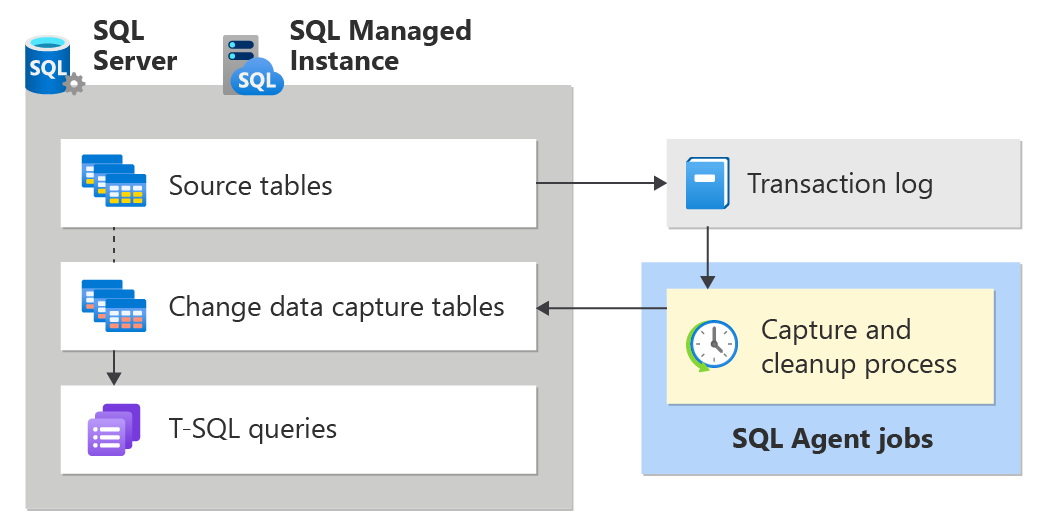![]()





Certainly! Let’s delve into Change Data Capture (CDC) in SQL Server, providing a comprehensive and detailed explanation of its features, implementation steps, use cases, and best practices.
1. Introduction to Change Data Capture (CDC)
Change Data Capture (CDC) is a feature in SQL Server that allows you to track and capture changes (inserts, updates, and deletes) made to your database tables. Unlike traditional methods like triggers or polling, CDC leverages the transaction log to identify and record changes, providing an efficient and scalable solution for data tracking.
Key Benefits of CDC:
- Minimal Performance Overhead: By reading directly from the transaction log, CDC minimizes the impact on database performance.
- Real-Time Data Capture: Enables near real-time tracking of data changes without the need for complex polling mechanisms.
- Historical Data Access: Provides a historical view of data changes, which is essential for auditing and compliance purposes.
- Integration with ETL Processes: Facilitates efficient data extraction for ETL (Extract, Transform, Load) operations, especially in data warehousing scenarios.
2. Understanding the Architecture of CDC
CDC operates by creating system-generated tables and jobs to capture and manage data changes. Here’s an overview of its architecture:
- CDC Tables: For each tracked table, CDC creates a corresponding change table that stores the historical changes.
- Capture Jobs: SQL Server Agent jobs (
cdc.<db_name>_capture) are responsible for reading the transaction log and populating the CDC tables. - Cleanup Jobs: Another SQL Server Agent job (
cdc.<db_name>_cleanup) periodically purges old change data to manage storage.
3. Enabling CDC in SQL Server
To utilize CDC, you need to enable it at both the database and table levels.
Step 1: Enable CDC at the Database Level
USE [YourDatabase];
GO
EXEC sys.sp_cdc_enable_db;
GO
This command enables CDC for the specified database. You can verify its status by querying:
SELECT name, is_cdc_enabled FROM sys.databases WHERE name = 'YourDatabase';
Step 2: Enable CDC on Specific Tables
USE [YourDatabase];
GO
EXEC sys.sp_cdc_enable_table
@source_schema = N'dbo',
@source_name = N'YourTable',
@role_name = NULL;
GO
This enables CDC for the specified table. You can check the status by querying:
SELECT name, is_tracked_by_cdc FROM sys.tables WHERE name = 'YourTable';
4. Querying Change Data
Once CDC is enabled, you can retrieve the captured changes using the following function:
DECLARE @from_lsn BINARY(10), @to_lsn BINARY(10);
SET @from_lsn = sys.fn_cdc_get_min_lsn('dbo_YourTable');
SET @to_lsn = sys.fn_cdc_get_max_lsn();
SELECT * FROM cdc.fn_cdc_get_all_changes_dbo_YourTable(@from_lsn, @to_lsn, 'all');
This function provides the changes between the specified log sequence numbers (LSNs), allowing you to track data modifications over time.
5. Managing and Maintaining CDC
Cleanup of Change Data
To prevent the CDC tables from growing indefinitely, SQL Server automatically sets up a cleanup job that purges old change data. By default, this job runs every 4320 minutes (3 days). You can manually trigger cleanup using:
EXEC sys.sp_cdc_cleanup_change_table
@capture_instance = 'dbo_YourTable',
@low_water_mark = <LSN>;
Monitoring CDC Jobs
You can monitor the status of CDC jobs by querying:
SELECT * FROM msdb.dbo.sysjobs WHERE name LIKE 'cdc%';
This helps ensure that the capture and cleanup jobs are running as expected.
6. Use Cases for CDC
CDC is particularly useful in scenarios such as:
- Data Warehousing: Efficiently capturing and loading incremental changes into data warehouses.
- Auditing and Compliance: Maintaining a historical record of data changes for regulatory requirements.
- Microservices Integration: Synchronizing data changes across microservices architectures.
- Real-Time Analytics: Feeding real-time data into analytics platforms for up-to-date insights.
7. Best Practices for Implementing CDC
- Limit CDC to Necessary Tables: Enable CDC only on tables where tracking changes is essential to minimize overhead.
- Regular Cleanup: Ensure that cleanup jobs are running regularly to manage storage and performance.
- Monitor Performance: Keep an eye on the performance impact of CDC, especially on high-transaction tables.
- Backup Strategy: Since CDC relies on the transaction log, ensure that your backup strategy includes regular transaction log backups.
8. Limitations and Considerations
While CDC offers numerous benefits, it’s important to be aware of its limitations:
- Dependency on SQL Server Agent: CDC relies on SQL Server Agent jobs, which must be running for CDC to function correctly.
- No Support for Non-Transactional Tables: CDC requires tables to have a primary key and support transactional consistency.
- Potential Performance Impact: On high-transaction tables, CDC can introduce overhead, so performance monitoring is crucial.
Change Data Capture in SQL Server provides a robust and efficient mechanism for tracking and capturing data changes. By understanding its architecture, implementation steps, and best practices, you can leverage CDC to enhance your data management processes, support real-time analytics, and ensure compliance with auditing requirements.
If you need further assistance with implementing CDC or have specific questions about its features, feel free to ask!
